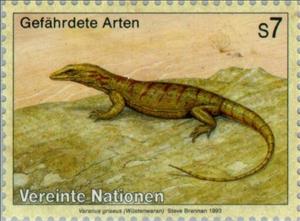Stamp: Desert Monitor (Varanus griseus) (UNO Vienna 1993)
Desert Monitor (Varanus griseus) (UNO Vienna 1993)
01 January (UNO Vienna ) within release Animals goes into circulation Stamp Desert Monitor (Varanus griseus) face value 7 Austrian schilling
| Stamp Desert Monitor (Varanus griseus) in catalogues | |
|---|---|
| Michel: | Mi:NT-WN 145 |
Stamp is square format.
Also in the issue Animals:
- Stamp - Grevy's Zebra (Equus grevyi) face value 7;
- Stamp - Humboldt Penguin (Spheniscus humboldti face value 7;
- Stamp - Desert Monitor (Varanus griseus) face value 7;
- Stamp - Wolf (Canis lupus) face value 7;
Stamp Desert Monitor (Varanus griseus) it reflects the thematic directions:
Reptiles are tetrapod (four-limbed vertebrate) animals in the class Reptilia, comprising today's turtles, crocodilians, snakes, amphisbaenians, lizards, tuatara, and their extinct relatives. The study of these traditional reptile orders, historically combined with that of modern amphibians, is called herpetology. Because some reptiles are more closely related to birds than they are to other reptiles (e.g., crocodiles are more closely related to birds than they are to lizards), the traditional groups of "reptiles" listed above do not together constitute a monophyletic grouping (or clade). For this reason, many modern scientists prefer to consider the birds part of Reptilia as well, thereby making Reptilia a monophyletic class.
Animals are multicellular, eukaryotic organisms of the kingdom Animalia (also called Metazoa). All animals are motile, meaning they can move spontaneously and independently, at some point in their lives. Their body plan eventually becomes fixed as they develop, although some undergo a process of metamorphosis later on in their lives. All animals are heterotrophs: they must ingest other organisms or their products for sustenance.


